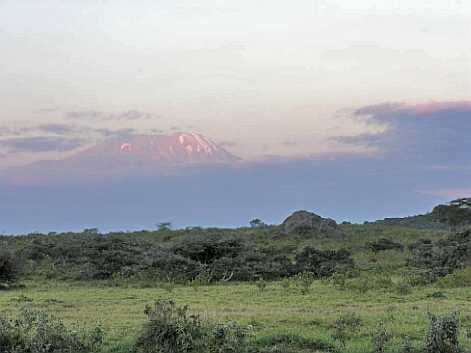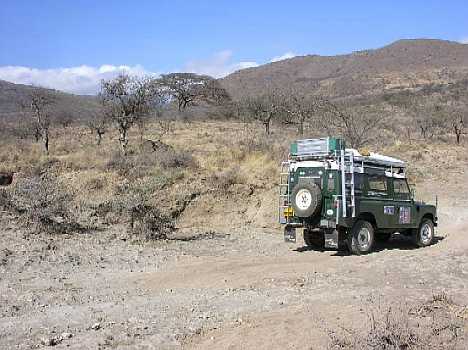

Travel log Tanzania - part 3
Thursday 21-09 (300 km)
After the first bone rattling 60 km from Bagamoyo, via Kikoko to Msata … … we knew it: yes … we are back on the road again!!! No more leisure weeks along the Indian Ocean, but a persistent push north to Lake Turkana on Kenya’s northern most frontier. At Msata we turn on the tarmac road to the north. There is not much traffic – accept the suicidal bloody busses – and we have some time to contemplate. In 10 days time it is 4 months ago that we left the Netherlands and so far we have covered exactly 15.000 km. To get home, which ever way, we need to cover another 15.000 km or, maybe, slightly less. For that, we have no more than two and a half months. So, there is little time to loose. Apart from that, the last couple of days the weather is changing and we will run into the “short” or “little” rains before long. That in turn, will significantly affect the roads we can choose from. Wa Bashasha is brave enough to venture on any road, but her driver, when he was young, has skidded over too many African mud roads for years and is not keen to re-live this experience. At midday, we enter Segera and when Paul turns into a petrol station we end up in front of a real motel: Segera Highway Motel. So far we have not encountered similar places elsewhere in Africa. The place is clean, the staff friendly and, we find out a little later, the buffet lunch tasty. The motel even has a safe camping place with clean ablution blocks and showers. Alas, its petrol pumps have run out of petrol! From Korogwe onwards, we slowly gain height and when we turn right in Mombo, we find ourselves on the steep climbing road to Lushoto, our final destination for today. For some 40 km, the road keeps going up and when we near Lushoto, the temperature has dropped considerably. Quite a change from the hot and humid Bagamoyo! Some kilometres before Lushoto, we find the guest house of the Usambara Sisters signposted and a few minutes later we enter the compound of the convent. A Montessori school, a clinic and all kind of other buildings set in beautiful landscaped gardens. Via a cobbled (!) road we reach the St Eugene guesthouse and are welcomed in the reception by three Sisters in charge. Our unit is magnificent: two beds with mosquito nets, a writing table and a bathroom. From our room we walk on the veranda and look out over the Usambara Mountains. The bedcovers are hand embroidered and when we take them off we find pressed white linen sheets. All this is so spotlessly clean that we wonder whether we are really in Tanzania. We will certainly not dare to go to bed tonight without taking a bath first, let alone doing things that might disturb the sheets and the minds of the Sisters! Dinner is another experience. A Sister writes the menu on a small slip of paper: soup, mashed potatoes and beef, vegetables, salad and dessert! Seven o’clock sharp. At 22.00 hours everything closes down … the Sisters have to rise early for prayers. Shortly before dinner it has turned so cold that we search for, and eventually find, our woollen sweaters. We had not put them on since our stay in the Kara o Mula lodge in Melanje in Malawi. Dinner is good and afterwards we sit for some time on the veranda of our room. I have smuggled the whisky bottle into our room – no alcohol in the convent – so Paul can enjoy his customary shot of single malt.
Friday 22-09 (340 km)
Breakfast is almost uncanny: home made bread, home made butter and home made gooseberry jam and Emmental cheese! Africa never fails to surprise. When we ask whether we can buy some home made jam and cheese we are taken to a different section of the compound: the place where these things are made and sold. The proceeds all go to the further development of the Sisters’ Montessori training centre. We put jam and the cheese in the Engel refrigerator, start the engine and begin our descend from the Usambara mountains back to the main road. At Momba we turn right to Same where we find another motel signposted: Elephant Motel. It looks a clean place, so we decide to stay for lunch. When we have ordered food, a girl addresses me. She is a member of a group of people from the City Council of Tilburg in the Netherlands. Tilburg has a linkage with Arusha and the group is here to visit various projects of the Council. When we meet the other members of the group we hear that one of the City Counsellors has just left: Gon Mevis. Yet another of one of those incredible coincidences. Gon is the same Gon with whom Paul travelled India for four weeks some years back! After lunch we continue our trip to Arusha via Moshi. Shortly before Arusha, in Usa River, we turn to the right towards the Gate of the Arusha National Park. The huge and often sharp stones limit Wa Bashasha’s speed to some 15 km per hour and together with the steep slopes, this causes our dreaded petrol supply problems again. When Paul orders me to quickly switch to the rear tank, he forgets that this tank is empty … consequently we get stuck on a steep rocky slope. When we arrive at the gate, it has become obvious that we are on a risky road and the knowledge that we have to continue this road for another 20 km (one and a half hours drive!) to reach Momella Wildlife Lodge, does not make us happy either. My spirits drop even lower when the rangers tell me that we have to pay US$ 70 for the two of us and US$ 40 for the car, just to cross the park to the Momela Wildlife Lodge, two kilometres outside the park! Yet, Paul insists that we continue and an hour and half later, and after suffering from petrol starvation twice, we arrive in the lodge without visible damage to the car. At that moment, the sky clears and we discover that Wa Bashasha is parked against the breathtaking eternal snow of the summit of the Kilimanjaro. Again, as it turns out, we ended up in a most peculiar place. Originally built by the Germans at the beginning of the 20th century, the lodge became quite popular in the late 1950s when it was the stage for Howard Hawks movie “Hatari!”, starring, among others, Hardy Kruger, Elsa Martinelli, Gerard Blain and John Wayne. After the film had become a world hit, Hardy Kruger stayed on and ran the lodge. In 1976 he was forced to give up the place and it was bought by an Indian. Somewhere in the mid 1980s, the place went bankrupt and changed into Tanzanian hands. The small wooden chalet we stay in – built in 1959 – is crumbling, but the beds are good and the linen clean and of good quality. We are rewarded for our persistence today when the sun sets on a snow covered Kilimanjaro.

Kilimanjaro at sunset
Saturday 23-09 (0 km)
In the morning it is cloudy and freezing cold and after breakfast we decide to have a rest day at the foot of the Kilimanjaro. We have a chat with a Tanzanian safari driver – who also runs his own small safari firm – and learn a lot about this type of business in Tanzania. A large part of the market is in expatriate hands and these people – according to our spokesman – work very closely together and keep each other in business. Africans are very suspicious of each other and – again according to our spokesman – as yet fail to work together to counterbalance the expat dominance. After midday we are shown around Momella Lodge by the Tanzania manager. It once must have been a magnificent place with cold storage rooms from the 1950s, an enormous kitchen with gas ovens from the same period, dining halls, various sitting rooms with open fires and huge wood fired boilers for the warm water. Most of it still functional but rather run down. Yet, all with a very appealing, at least to us, atmosphere. Paul is a little worried about Wa Bashasha’s condition: one of the front wheel oil seals leaks oil through the freewheel hub and the window attachment to the bulkhead is rattling again. The latter might become a serious problem. There is far too much weight (roof rack and tent) on the window frame and due to the extremely bad roads the outside attachments, welded onto the bulkhead, have almost sheared off. Topsleeper in Vessem should have known, ….but that is crying over spilt milk. We decide to go to the famous “Tony and George” garage in Njoro in Kenya, to have some serious work done on the car. Until then we hope that the car remains in one piece.
Sunday 24-09 (380 km)
At 09.00 we are on our way to Thika, some 40 km north-east of Nairobi in Kenya. Since I absolutely refuse to pay a ridiculous 110 US$ again to drive to the tarmac road via the Arusha National park, we head north over a track towards … This decision yields, unexpectedly, the first serious off road driving. The stony road, becomes a track with huge boulders and when we cross the first dry river bed, Paul has to do a fair amount of manoeuvring to get the car over the rocks. Luckily they are not sharp, but rounded.

The first serious off road driving
The environment becomes drier and drier and even at our low speed, we are trailing enormous clouds of grey and black volcanic dust. The pictures we make are excellent covers for a book about travelling Africa over land. They are also the ultimate homage to the designers of the Land Rover Series III. Toyota Landcruisers you see everywhere in Africa nowadays, Land Rover has lost that market for ever, but so far not one Landcruiser we saw was older than 20 years. Land Rovers, some more than 40 years (!) old, we see almost every day. As towing vehicles, farm transport and mini busses. At Lariboro, we find the tarmac road again and it takes us less than three quarters of an hour to reach the Tanzania-Kenya border at Namanga. Although it is a Sunday, lots of people are passing the border in both direction and we are a little anxious that it will take us a lot of time to get across. That, however, is not true. Although again we encounter a young, unfriendly and rude Tanzanian immigration officer, in less than 30 minutes we make our way to the Kenyan side. Here, contrary to Tanzania, immigration and custom personnel has apparently received public relation training and we are received and helped as very welcome guests. When we left Momella Wildlife Lodge, we heard some terrible stories about the road from Namanga to Nairobi, but they are made up: the road is good and early in the afternoon we enter, after 14 years, Nairobi again. It takes some time to get through the centre, but at 15.00 hours we are on Thika Road heading towards the Blue Post Hotel in Thika. After experiencing some problems finding the place, we finally park Wa Bashasha in the secure parking lot, and half an hour later we meet Eelco and Huub (Eelco’s father) Manderveld. Both will accompany us on our tour through Kenya. We will have to be back in Nairobi on 14th October to put Huub on the plane to Amsterdam. Eelco will travel back with us to Holland.
© 2005-2006 Paul and Meta Lapperre - Website by MvS
